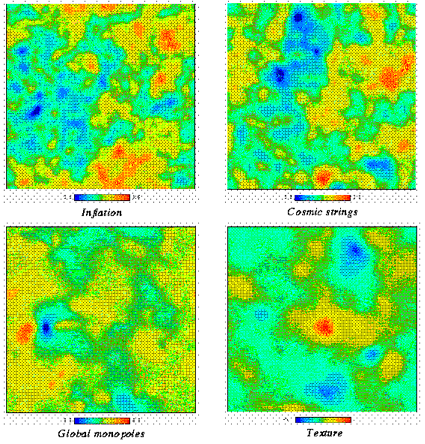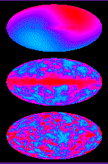Relic Radiation from the Primeval Fireball
About 380,000 years after the Big Bang, the temperature of the Universe had dropped sufficiently for electrons and protons to combine into hydrogen atoms, p + e ⇒ H. From this time onwards, cosmic radiation was effectively unable to interact with the background gas; it has propagated freely ever since, while constantly losing energy because its wavelength is stretched by the expansion of the Universe. Originally, the radiation temperature was about 3000 degrees Kelvin, whereas today it has fallen to only 3K.
Observers detecting this radiation today are able to see the Universe at a very early stage on what is known as the 'surface of last scattering'. Photons in the cosmic microwave background have been travelling towards us for over ten billion years, and have covered a distance of about a million billion billion miles.
The Temperature of the Universe Today
Measurements of the cosmic microwave background radiation (CMB) allow us to determine the temperature of the Universe today. The brightness of the relic radiation is measured as a function of the radio frequency. It is approximately described by thermal radiation distributed throughout the Universe with a temperature of about 2.735 degrees above absolute zero. This is a dramatic and direct confirmation of one of the predictions of the Hot Big Bang model.
The Cosmic Background Explorer (COBE) satellite measured the spectrum of the cosmic microwave background in 1990, showing remarkable agreement between theory and experiment. The diagram to the right shows the results plotted in waves per centimetre versus intensity. The theoretical best fit curve (the solid line) is indistinguishable from the experimental data points (the point-size is greater than the experimental errors).
Ripples at the Edge of the Universe
The COBE satellite was launched twenty five years after the discovery of the microwave background radiation in 1964. In spectacular fashion in 1992, the COBE team announces that they had discovered 'ripples at the edge of the Universe', that is, the first sign of primordial fluctuations at 380,000 years after the Big Bang. These are the imprint of the seeds of galaxy formation.
These appear as temperature variations on the full sky picture that COBE obtained. They are at the level of only one part in one hundred thousand. Viewed in reverse the Universe is highly uniform in every direction lending strong support for the cosmological principle.
The thumbprint image below shows the temperature of the Universe in all directions projected onto a plane (similar to a map of the earth):
1.The raw temperature map (top) has a large diagonal asymmetry due to our motion with respect to the cosmic microwave background - a Doppler shift.
2.The temperature fluctuations after subtraction of the velocity contribution, showing primordial fluctuations and a large radio signal from nearby sources in our own galaxy (the horizontal strip).
3.The primordial fluctuations after subtraction of the galaxy signal.

Examples of different fluctuation patterns seen from different topological defects
The Origin of Fluctuations in the CMB
There are a variety of competing theories for the origin of large-scale structure and the fluctuations in the cosmic microwave background radiation. These models fall into two categories: (1) causal topological defect models, such as cosmic strings and textures, or (2) inflationary scenarios.
Examples of the different cosmic microwave fluctuation patterns that they create are shown below for maps of a few degrees. The random features of inflationary models and cosmic strings are quite similar, being quite distinct from the stronger features for other defects. Experimental improvements in the study of such small scale CMB fluctuations should lead to discriminating tests between these different models.



